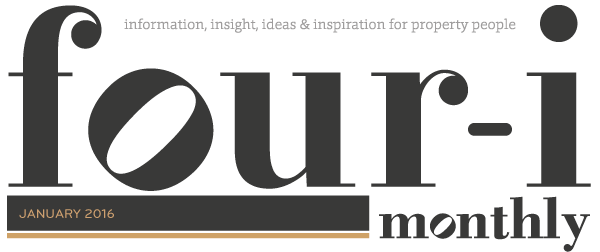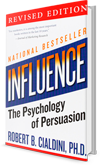
CIALDINI INFLUENCE
Influence: The Psychology of Persuasion by Robert B Cialdini

When Professor Robert Cialdini moved from the halls of academia into commerce, his team in the UK engaged The Property Academy to help design and produce training materials for the “Principles of Persuasion” programme based on the 1984 bestselling book “Influence: The Psychology of Persuasion.” Meeting with Bob Cialdini to assist with this project, we gained another level of insight to his concepts and have used these with many clients to assist them to become more effective.
Cialdini asserts there are just six ways you can influence someone, each with many applications and also with one overarching amplifier – we’ll summarise these and show how when used in concert, they become even more powerful.
1. AUTHORITY
We are influenced by experts and authority figures. This conditioning starts with our parents, then teachers and continues into the workplace. The Boss’s opinion counts for more than most in many companies, regardless of whether it’s the best.
Corporations, institutions and long established groups tend to have more authority and consequently influence than recent entrants.
An expert witness has more authority than a normal member of the public. Of course many authorities are expert and have earned this position through years of study and practice, but there are ways to capitalise on this principle of persuasion that might surprise you.
Cialdini’s own research and that of other psychologists highlights that we respond more readily to people who are dressed authoritatively.
One experiment involved actors stopping a passer-by and asking them to cross the road. People were more than twice as likely to be influenced when the request was made by someone dressed in a security guard uniform (92%) compared with when they were wearing jeans and a T-shirt (42%).
In Influence – Science & Practice, Robert Cialdini cites studies where donning a straightforward business suit can have equal effect. In one such experiment, 350% more people were willing to follow a man crossing the street against a red light, against the traffic and against the law when the request was made by an individual wearing a suit rather than casual clothes.
A UK study demonstrated that people were more likely to recall health messages when the healthcare professional had a stethoscope draped over their shoulders than when no stethoscope was present.
The stethoscope acted as an instrument to inform the patient of the wearer’s credibility and knowledge.
So, think about the impact of what you wear – from your choice of clothing to the tools of the trade that you carry such as camera equipment and valuation packs – since used ethically, they have an effect on the likelihood that people will be influenced by what you have to say.
We are similarly influenced by titles, a “Managing Director” will carry more weight than a “Manager” and this is amplified further if someone else makes the introduction: “This is Peter our Managing Director” carries more influence than “hello I’m Peter, the Managing Director.”
One of Cialdini’s team applied this principle within an estate agency: when answering enquiries the receptionist changed her script to: “I’m going to connect you to Simon, he’s our house sales expert with 12 years experience in your area.”
They saw a significant improvement in conversion rate with just this one change.
2. LIKING
We prefer to do business with people we like; what’s more, we like people like us. The more we identify with someone, the more we’re likely to be influenced by them.
This similarity isn’t restricted to appearance – if we find someone has similar interests, no matter how small or obscure they may seem, we will prefer to do business with them rather than another where there’s no obvious common ground.
Cialdini refers to people that abuse the principles of persuasion as “bunglers” and this description would apply to those who try too hard to be liked.
Much better is to find something about the other person that you genuinely like – people subconsciously pick up when someone likes them and this in turn causes them to reciprocate.
3. SOCIAL PROOF
Social Proof is turbocharged liking. We look to see what others are doing – the choices they have made – and are influenced by them. This is particularly the case when there is uncertainty or where there are different options that appear to yield an equal outcome. As well as powering fashions and fads, social proof also allows the inferior to win over the better competitor.
If more people use product A than B then even if B is better and cheaper it can be very difficult to cause an audience to switch. This is why, in estate agency, market share is so important and there’s no better way of displaying your share than by the number of boards you have with sold and let signs displayed – boards breed boards, it’s social proof in action.
4. RECIPROCATION
Hundreds of experiments by leading sociologists have identified and confirmed that it’s a human need to repay debts, acts of kindness and social graces and that often, the repayment can be disproportionate to the initial “gift”. This is why reciprocation is such a powerful tool for influencing people.
Bunglers give with condition, “if I do this, then will you do that?” whereas master practitioners know that to give without condition will generate much better results. Agents have many opportunities to apply reciprocity, yet all too often bungle it.
Prospects that aren’t ready to move just yet tend to be disregarded as timewasters, but if instead they were to be seen as they really are – future opportunities – to win them just requires an investment in true help and assistance.
5. COMMITMENT & CONSISTENCY
Psychologists know that people have a need to be seen to be consistent with their words and actions. Put it another way, we dislike and mistrust those that are inconsistent and who break or who are reluctant to make commitments.
Cialdini’s research highlights many examples where this principle of influence can be used to great effect; they have in common starting small and growing larger.
Asking for and receiving something small is much easier than something larger. A small favour that takes a few minutes is easy to accept, but in doing so the principle of commitment and consistency is activated.
If you can persuade someone to make a small commitment, for example asking an owner, “when you come to sell your property will you call me?” and then confirm this to them in writing, you will dramatically increase the likelihood that they will be in touch when the time is right.
Better still if you ask them to confirm in writing and in a way that requires a reply.
6. SCARCITY
If we can’t have it, we want it more: Tickets to the game, reservations at the restaurant or theatre, flights on the day we wish to leave – the harder it is to get something, the more valuable it becomes. Things that are rare are more valuable than those that are ubiquitous. If we know that others also want what we do and that only one can win, then the value increases, often to a ridiculous level as many auctions highlight.
This is the most frequently used principle of persuasion by agents, “we have several others interested…”, but whilst its effect is proven for properties, how about using it for your services? Rather than a “we can come whenever you want us to” approach, what if you and your services were to be that bit rarer? “I already have appointments with seven clients on Tuesday, but can rearrange things to accommodate you at 4pm, does that work?”
Taking it further, “I have a strict limit on the number of VIP clients I work with and have only have one position vacant, would you like me to take personal care of all your requirements and to make you aware of new properties ahead of the market?”
CONTRAST AND COMBINE
Although Cialdini only highlights six principles of persuasion he makes the point that they can all be amplified when combined with the use of the contrast principle – things seem bigger or smaller, cheaper or more expensive, better or worse in contrast.
Again, many agents use this to powerful effect; “this property is so much larger/better/cheaper than the others…” the key is to combine contrast when using one or more of the other influencing tools.
The more of the principles you use together, the more persuasive you will become.
For example, take an award-winning expert (authority), who is regularly featured in key media (social proof), is only available for a limited time (scarcity), but gives you a free initial private appointment (reciprocity), during which you find you have much in common (liking) and after which you receive a personal note (commitment and consistency) which is so different to your experiences with others (contrast) – it’s near impossible to resist.
We know Bob Cialdini to be a decent man, who is concerned that these principles of persuasion are used ethically and appropriately. Inevitably there will be some that see them as a shortcut to success, but they are the ones that miss the point.
If you already have the necessary qualities, these influencing techniques just assist in both you and your clients achieving what you both want.
One final thought, these principles apply equally to all communications; your advertisements, brochures, direct mail, etc. so consider which you’re using or could employ with each and every marketing initiative.
![]()